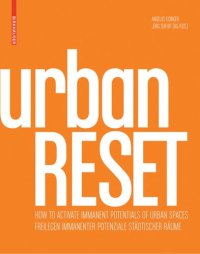
Ebook: urbanRESET: Freilegen immanenter Potenziale städtischer Räume / How to Activate Immanent Potentials of Urban Spaces
- Year: 2012
- Publisher: Birkhäuser
- Edition: Enthält eine Printausgabe und ein eBook
- Language: German
- pdf
Building tomorrow’s city by reinterpreting existing urban spaces
In recent years and decades, dealing with the architectural legacy of the industrial age has been an increasingly common task for urban planning: industrial buildings and sites, infrastructure, and residential areas that have become vacant lots as a result of structural transformation cannot, if only because of their dimensions, be ignored within the urban space. Innovative reinterpretations of such relics that update existing building fabric in a way that goes beyond critical reconstruction or revitalization, such as the Toni Site in Zurich or the Île de Nantes, can be observed throughout Europe these days.
The publication urbanRESET brings together succinct examples of this separate category of urban-planning from throughout Europe. The projects are presented in detail with plans and color illustrations. Interviews with key players and theoretical essays show how local processes of reinterpretation and reactivation can produce sustainable effects. urbanRESET sheds light on the common foundations of these works and condenses them into methodological inferences for a forward-looking urban praxis.
- A well-grounded discussion of a current phenomenon in urbanism with projects presented in detail
- The authors and interviewees include: Kees Christiaanse, Harry Gugger, Martin Heller, Thomas Sieverts, and Daniel Niggli of EM2N
- For architects and urban planners, historians, scholars in social and cultural studies, and political scientists and economists